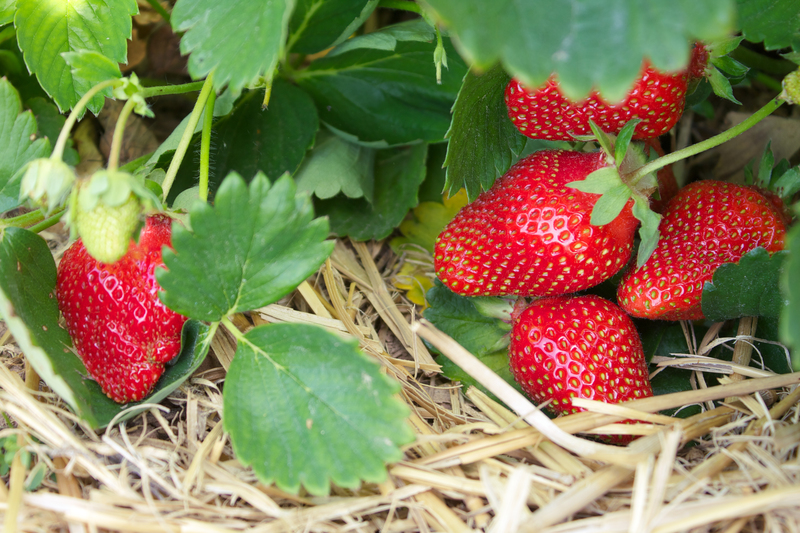Harness the Power of Your Garden to Fight Climate Change
Posted on 24/06/2025
Climate change is one of the most pressing issues of our generation. While global action is crucial, every individual can make meaningful contributions on their own property. Your backyard garden, no matter the size, holds untapped potential to help mitigate climate change. By making conscious choices and employing sustainable practices, homeowners and gardening enthusiasts can transform their green spaces into powerful allies in the fight against global warming.

Introduction: Your Garden's Hidden Climate Superpowers
Did you know that gardens can help counter climate change? Beyond their beauty and bounty, gardens play a vital role in absorbing carbon dioxide, supporting biodiversity, reducing energy usage, and creating resilient ecosystems. By adopting climate-conscious gardening techniques, you replace carbon-emitting lawns and hardscapes with plant-rich landscapes that absorb, rather than emit, greenhouse gases.
Here, we'll explore a comprehensive guide to harnessing the power of your garden--with actionable steps, scientific evidence, and inspiring ideas--for everyone, from seasoned gardeners to those new to growing food and flowers.
How Plants and Soil Trap Carbon
Understanding Carbon Sequestration in the Garden
One of the key ways that gardens combat climate change is through carbon sequestration. Plants, through photosynthesis, absorb carbon dioxide--a primary greenhouse gas--from the atmosphere and store it in their tissues and in the soil. Healthy soils act as giant sponges for carbon, locking it away for decades or longer.
- Trees and Shrubs: Woody plants store carbon in their trunks, branches, and roots, making them some of the most effective garden carbon sinks.
- Perennials: Unlike annuals, perennials' robust root systems lock more carbon below ground and disturb the soil less.
- Soil Health: Practices like mulching, composting, and reduced tilling guard the soil's carbon and build its storage capacity.
Tip: Leave the leaves! Mulching garden beds with fallen leaves returns organic matter and carbon to the soil while providing food for earthworms and microorganisms.
Embrace Rewilding: Let Nature Thrive
What is Garden Rewilding?
Rewilding involves letting parts--or all--of your garden grow in a more natural, untamed state. This approach increases carbon capture, biodiversity, and ecosystem health.
- Convert lawns: Replace unused turfgrass with native wildflower meadows or naturalized areas.
- Create "wilder" corners: Leave undisturbed patches for wildflowers, native grasses, and spontaneous vegetation to provide habitats for pollinators and wildlife.
- Plant trees: Even a single tree can make a major difference in carbon sequestration and ecosystem support.
Rewilding not only makes your garden more resilient to climate extremes--like droughts and floods--but also saves you time and reduces the need for water, fertilizers, and mowing.
Plant an Array of Species for a Resilient Climate Garden
The Power of Biodiversity in Your Climate-Fighting Garden
Diverse gardens are more productive, attract beneficial insects, and are better at adapting to changing conditions. A mix of plant types builds ecological resilience, reduces pest issues, and optimizes carbon capture.
- Mix trees, shrubs, vines, perennials, and annuals for structural and species diversity.
- Prioritize native plants--they typically require less water and fertilizer and support local wildlife.
- Cultivate pollinator-friendly species like milkweed, asters, echinacea, and lavender.
- Use companion planting and crop rotation in your vegetable beds to maintain soil health and reduce disease.
More plant diversity = more climate benefits. It's that simple!
Adopt Sustainable Gardening Practices
Low-Impact Methods for a Climate-Conscious Garden
- Composting: Transform yard and kitchen waste into rich, carbon-sequestering soil amendments. Composting also cuts methane emissions from landfill waste.
- Mulching: Use organic mulch to smother weeds, retain moisture, protect soil life, and return nutrients and carbon to the earth.
- Reduce Tilling: Dig and till only as needed. No-dig gardening preserves soil structure and the carbon stored within.
- Leave Grass Clippings: Let them decompose on the lawn to nourish your soil and minimize waste.
- Use Organic Fertilizers: These support microbial activity that aids long-term carbon storage.
Switching to sustainable methods reduces your garden's carbon footprint and helps reverse global warming--right outside your door.
Make Water-Wise Choices
Save Water, Save Energy, Slow Climate Change
Did you know that water use is closely connected to energy consumption and greenhouse gas emissions? Transporting, treating, and heating water requires fossil fuels. By designing water-wise gardens, you save resources, money, and help curb climate change.
- Install rain barrels: Collect free, low-carbon rainwater for irrigation.
- Plant drought-tolerant species: These thrive with little watering and handle heatwaves with ease.
- Group plants by water needs: Reduces overwatering and runoff.
- Use drip irrigation: Delivers water only where it's needed, minimizing evaporation and waste.
- Build healthy soil: Amended soils retain more moisture, decreasing your garden's thirst.
Water-smart gardens are essential for a sustainable, climate-ready landscape.
Ditch Chemicals for a Healthier Planet
Reduce or Eliminate Chemical Pesticides and Fertilizers
Chemical lawn and garden treatments rely on fossil fuels for their production, transportation, and application. Moreover, they often degrade soil carbon, harm beneficial organisms, and disrupt ecosystems. Going organic supercharges your garden's climate potential:
- Enrich with compost instead of synthetic fertilizers.
- Control pests naturally: Use plant diversity, beneficial insects, and barriers to manage bugs without chemicals.
- Control weeds organically: Hand-pull, mulch, or use natural herbicides made from vinegar or boiling water.
Each chemical-free action protects your garden's pollinators, preserves healthy soil, and prevents harmful runoff into waterways.
Cultivating Food for Planetary Health
Grow Your Own Food and Cut Carbon Emissions
The global food system is a major source of greenhouse gases--thanks to fertilizer use, shipping, refrigeration, and packaging. By growing your own fruits, vegetables, and herbs, you shrink your carbon footprint and eat fresher, healthier produce.
- Start a home vegetable patch, raised beds, or edible containers.
- Integrate fruit trees and berry bushes into your landscape.
- Try vertical gardening or small-space intensive techniques for maximum yield in any size garden.
- Compost all garden and kitchen scraps to create a closed-loop, zero waste garden.
Even a small patio or balcony can support herbs, tomatoes, or salad greens--a delicious climate solution at your fingertips.
Maximizing Your Garden's Climate Impact
Take Your Climate-Friendly Garden to the Next Level
- Share your surplus: Give away or swap extra produce with neighbors, reducing food waste and building community.
- Educate others: Host tours or workshops to inspire neighbors to adopt sustainable practices.
- Advocate for local policies: Support tree planting programs, green infrastructure, and pesticide bans in your area.
- Certify your garden: Seek designations such as "Certified Wildlife Habitat" or "Pollinator Friendly Garden" as badges of honor--and inspiration.
Your garden can spark a climate revolution--from the ground up. Every tree, flower, and compost pile is part of a larger movement to restore nature, absorb carbon, and safeguard our planet's future. By taking simple, science-backed steps, you harness the power of your garden to fight climate change every day.

Conclusion: Sow Seeds for a Greener, Cooler Tomorrow
If you want to combat climate change, don't just look to far-off policies or distant power plants--start right where you are. Every home garden has the power to become a carbon sink, wildlife sanctuary, and hopeful example for others. By embracing climate-smart gardening techniques, you actively contribute to a healthier, cooler planet--one plant at a time.
So grab your shovel, let your wildflowers bloom, plant a new tree, and welcome nature back into your yard. Your climate action begins at home--and it grows every season.



